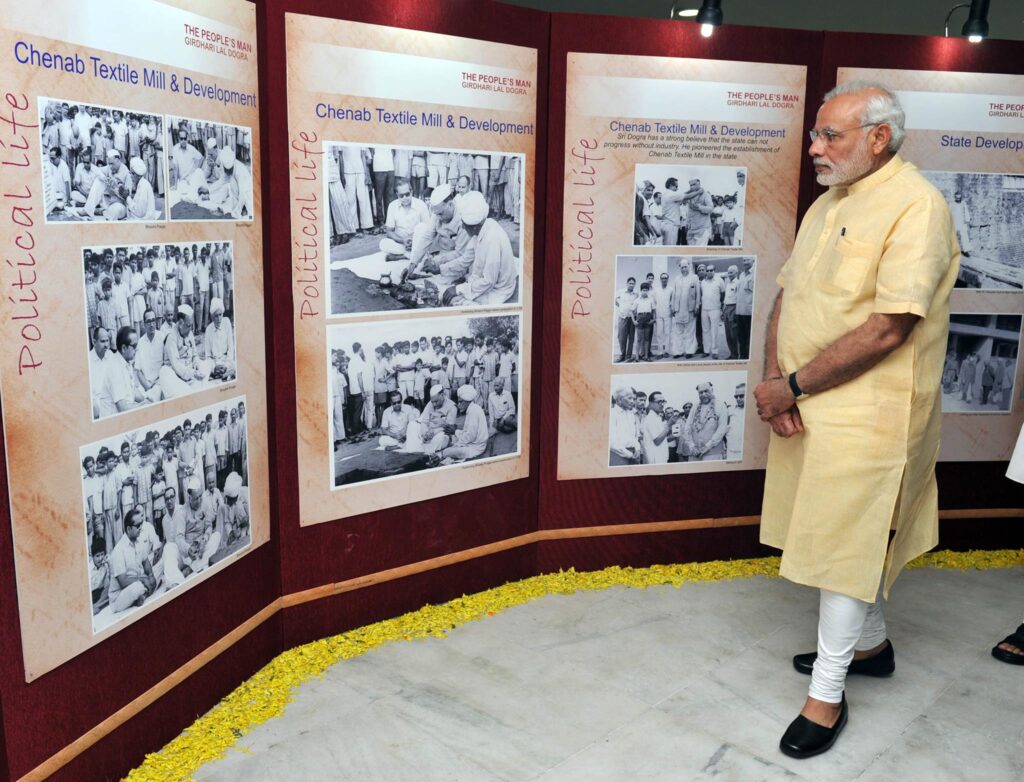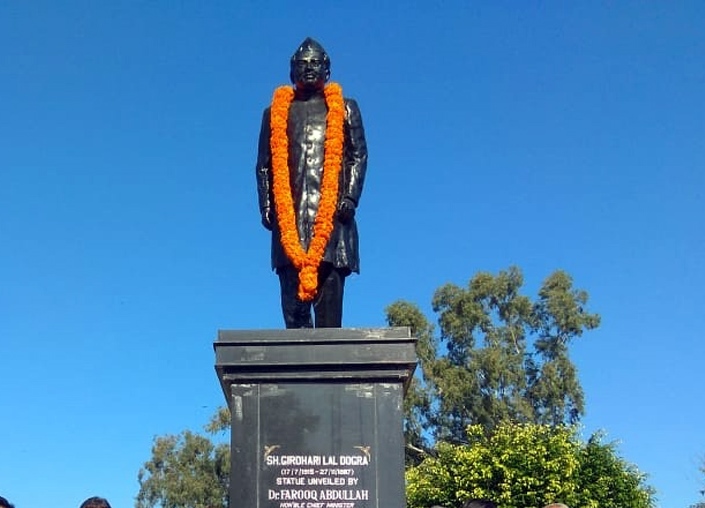A khadi clad man with superior height and striking good looks and yet, a picture of calm and composure – Girdhari Lal Dogra was a man of virtues. His honesty, integrity and sincerity towards his service and his people is hailed till date. He made his mark as the longest serving Finance Minister of J&K and had the unique distinction of being the Finance Minister of Sheikh Abdullah, Bakshi Ghulam Mohammad, Shamas ud din, Shri G. M. Sadiq and Syed Mir Qasim. This in itself is an eloquent testimony of his capacity and capability.

Like PM Modi said while addressing the audience during his birth centenary – He was one of those very few gems who are remembered with dignity even after their death.
CHILDHOOD
Girdhari Lal went on to become one of the most enduring icons of political scene and devoted his entire life to public service. He had come this far only because of his perpetual honesty and sincerity- his family had no political connection and not even ample money but his perseverance assisted him in overcoming every obstacle that came his way. He was born in a middle class family on July 17th, 1915 in a remote village ‘Bhaiya’ in Hira Nagar. Family was huge, money was short and opportunities were slim, so to feed the family Girdhari’s father moved to Amritsar for work, leaving his farmer life behind. Girdhari Lal was born twenty years after the marriage and most of his childhood was spent in a modest home – a Kuchha house, with the walls and floor made of ‘mitti’.
EDUCATION
The village lacked a school and the nearest one was at a distance of four kilometers. Till eighth standard he studied at Hira Nagar and for matriculation he would travel 15 kilometers to Samba but that would never deter him. He understood the importance of education even at that tender age. He would leave home in the wee hours, cross the forest and barren land and return home late in the evening. Only two boys had appeared for Std X from their village at that time and Girdhari was one of them. Unaffected by the hardships, he went on to graduate from Hindu college. With the help of his younger uncle, he proceeded to Lahore to do his L.L.B in the midst of independence struggle.
Girdhari Lal was a determined man who firmly believed his instincts would guide him in all situations, and it was the same even in the matter of love. Once Girdhari Lal had gone to pay a visit to Pandit Premnath Dogra, one of the greatest leaders of J&K, his eyes fell upon Shakuntala- Prem Nath’s brother’s daughter. The moment he saw Shakuntala, he decided she would be the one he would marry, and it would be no other. The life of a Politician, or a government servant is a demanding one to say the least and he would find very less time for family between campaigning, providing audience for the people’s problems, finding subsequent solutions, planning for the future of state. She respected his principles and the resilience and strength and understood his lifestyle without ever complaining about his hectic schedule or even financial constraints. They were contrasting personalities who complemented each other. When Shakuntala was unable to conceive for fourteen years, he was mounted with the pressure of remarrying as it was a common practice at the time, but he stood by her like a true life partner, providing unfailing support and unconditional love. In 1956, the couple was blessed with a beautiful baby girl and in 1962, they were bestowed with another baby girl. He adored both of them and was a doting father. His chest would swell with immense pride when he would talk of his girls.
Read also: All you need to know about SKUAST Jammu
POLITICAL YEARS AT THE STATE
Upon returning to Jammu, he began a number of initiatives such as ‘Zamindara Urdu weekly’ against the landlords, which took into account all the complaints his grandfather would receive. He was appointed the magistrate or Emergency Officer of Kathua, in charge of taking care of the refugees from both the sides of the border during the partition. He made the most of this opportunity and did a commendable job, tirelessly working diligently to ensure as much as could be done to make their lives better. He was inspired from the principles of Dr. Saifuddin Kichlu and Gandhi and believed in absorbing himself completely in the betterment of the lives of those around him. His popularity and quality of work impressed Sheikh Abdullah and he was asked to join the Cabinet and in 1948, he was sworn as Finance Minister- making him the youngest minister at the time. Soon after, in September 1951, Girdhari Lal contested and won his first elections, which marked the beginning of his clean streak of victories at the polls. His first stint as the Finance Minister ended in 1957 though he remained a member of the Assembly till 1980. At the end of 1960, an offer was made for the four leaders of the Democratic National Conference to rejoin the ministry upon its dissolution and Girdhari Lal Dogra was allotted the portfolio of law and finance. Re elected for another term yet again, this time Girdhari Lal was given Revenue, Rehabilitation, Food and Supplies to look after from 1967-69, and for the year 1970 he looked after Finance, Planning and Labour. During the year 1969-70 he was also the chairman of the Estimates Committee. Girdhari Lal Dogra’s last stint at the state level was from February 1971-1975 at the helm of the departments of Finance, Planning, Law and Tourism, Industries and Labour. Continuing his unbroken record of victories at the polls he was elected from Jammu to the seventh Lok Sabha in 1980 and in 1984, he was elected to the eighth Lok Sabha from Udhampur.

PEOPLE’s MAN
He gave in his time, energy, dedication devotion and undivided attention and understood that for a leader, maintaining a personal connection with the people is necessary. His house was known be to be open one. Anyone who wished to speak with him could simply drop by the house and he would lend an ear and he would never let anyone leave without a meal. Adorned in a Nehru jacket and with a walking stick in his hand, he would walk through the villages in his constituency, greeting and talking to whomever he came across. His availability and keenness to genuinely be there for his people is what garnered respect for him.
With inputs and images from ‘The People’s Man- A Biography of Girdhari Lal Dogra’.
















